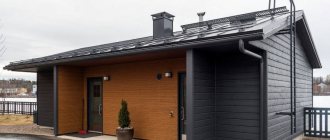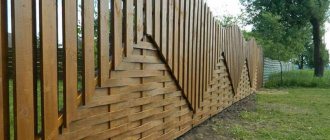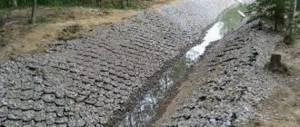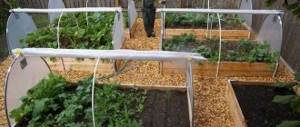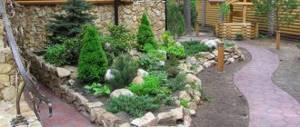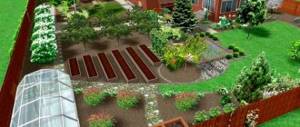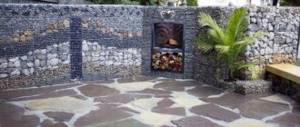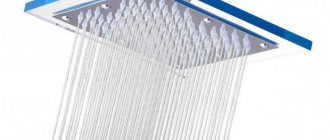Need for watering
When purchasing a lawn, you need to remember that it needs moisture, and surface watering will not be enough. For it to be considered correct and of high quality, it is necessary to ensure that water penetrates into the soil at a distance of at least 5-6 cm, which will help maintain colorful greenery for the lawn.
Not everyone has the opportunity to pay a lot of attention to their lawn. This is where automatic lawn watering comes to the rescue, caring for the lush greenery of the lawn on its own. You only need to carefully configure its automation according to the instructions.
Do-it-yourself irrigation system development
It is not difficult to organize automatic watering of the garden with your own hands. First you need to take a site plan to scale. If it is missing, it needs to be drawn on graph paper or on a large checkered piece of paper. Place all large plants, beds and buildings on paper.
- Configuration development. Mark the location of the water source and irrigation zones on the plan. Along the way, you need to draw the passage of the main pipeline. If you plan to spray with sprinklers, you need to draw their zones of action. They should intersect with each other and there should be no unwatered areas.
In the case when plants are planted in rows, it would be more advisable to use drip irrigation: the cost of equipment and water consumption are much less. When developing a drip irrigation scheme, the number of irrigation lines depends on the distance between the rows. In the case where the inter-row distance is more than 40 cm, one line is required for each. If the distance between the rows is less than 40 cm, watering is one less line.
After drawing all the sections, you need to decide on the length of the required pipelines, you need to calculate how many and what water distribution points you have, decide on the equipment - the number of hoses, tees, sprinklers, droppers and pipes. Is a gearbox and pump required, is a container required, and what kind of automation will be installed in what place. After the stage of calculating the necessary materials and designing the system on paper is completed, you can begin installation. The irrigation system that was designed on paper begins to be implemented on your site.
- Construction. Firstly, what you need to decide on is the laying of pipes. There are two ways to lay a pipeline: bury it in a trench or lay it on top. At the dacha they usually lay it on top, since watering here is seasonal and the entire system is dismantled in the fall. With rare exceptions, the system at the dacha is left non-removable; if the system can withstand low temperatures, it can simply be broken or stolen by ill-wishers.
They try to make the automatic irrigation system for the site of a permanent residence as inconspicuous as possible, so the pipes are buried. In this case, trenches are dug at least 30 cm deep. This depth is optimal in order not to damage the pipes during excavation work. You just need to remember that all equipment remaining for the winter must withstand low temperatures.
Branches go from the main water pipelines for irrigation. It is best to make all connections and assemblies in hatches with covers: since leaks most often occur in connections and tees. To find a leak, digging a trench is not the most pleasant task, but when access to problem areas is easier, system maintenance is greatly facilitated.
The last step, depending on the chosen irrigation method, is to install water distribution devices into the hoses, everything is connected and checked.
- Accessories. All piping throughout the site is made from polymer pipes. Pipes made from this material do not react to most fertilizers, are corrosion resistant, reliable and easy to install (they do not require any installation equipment). HDPE (low-density polyethylene) pipes are the most popular. To all the advantages described above, it is worth adding UV resistance: they can be laid on the surface. You can also use LDPE (high-density polyethylene), PVC (polyvinyl chloride, but this material is afraid of ultraviolet radiation) and PPR (polypropylene, the disadvantage of this material is that its connection must be carried out by welding and eliminates the possibility of dismantling).
For an automatic irrigation system in a country house, garden, or greenhouse, a pipe with a diameter of 32 mm is usually used. If a large number of beds must be watered, it is recommended to take a pipe with a diameter of up to 40 mm.
HDPE pipes are assembled using compression fittings (with threaded gaskets). Pipes made of this material are able to withstand the pressure in the water supply of a multi-story building, so they can withstand the pressure for watering the area without problems. The advantage is that at the end of the season they can be dismantled and assembled and used again the following year.
If the choice falls on drip irrigation, drip hoses or tapes must be connected to the main line; you can attach ordinary droppers to the hoses (a hole is made and a small device is inserted into it). For rain irrigation, sprinklers are installed. They come in different structures and are capable of covering areas of different sizes and shapes - rectangular, round, sectors. A DIY lawn watering system is also easy to install.
Irrigation Variations
There are fundamentally different designs that are mounted separately in different cases:
- for flower beds and greenhouses;
- lawns;
- entire summer cottages.
An optimally selected irrigation system can increase productivity and reduce water consumption; in addition, it will greatly improve the appearance of plants planted on the site. This largely depends not only on regular, but also on uniform watering of the area.
Automatic watering of an area with trees Source i.pinimg.com
The landscape irrigation system contains the following components:
- hoses;
- taps;
- valves;
- controllers;
- sprinklers.
All this functions thanks to specially configured programs that operate according to their clearly defined schedule.
An automatic watering system is installed before sowing the grass mixture. This is because laying pipes requires removing the top ball of turf. An alternative option is a drip irrigation system. However, it must be taken into account that they are not capable of serving large lawns.
Automatic watering: types and possibilities
Today there are quite a lot of systems for organizing automatic irrigation in the country that you can make yourself. They all differ in their purposes of application: drip irrigation; sprinkling; subsurface irrigation.
Drip irrigation . The drip irrigation system is advantageous in that it allows for minimal water consumption. The main elements for its production are polypropylene and plastic pipes and rubber hoses, which are installed between rows of flowers, plants or beds.
They are placed as close as possible to the plantings in order to ensure, when used, the maximum amount of water that will flow to the root system. To supply water to the ground, special droppers are provided, which are built in along the entire length of the pipe.
As a result, with this method of watering, the leaves and stems remain dry, and this is undoubtedly a plus for the plants, since they will not get sunburned.
The minimum water consumption when using an automatic drip irrigation system is ensured due to the fact that the water flows directly to the irrigation site.
As a result, it is not wasted on irrigating other unnecessary areas. All this only benefits the summer resident, since it extends the working life of the system and also allows saving on water consumption.
Sprinkling
Automatic watering systems operating on the sprinkling principle are also often used by many summer residents. When used, moisture reaches the plants in the form of splashes , covering the entire area evenly.
The effectiveness of this system is ensured by the fact that not only the soil receives a sufficient amount of moisture, but it is also possible to maintain an optimal level of air humidity. In such conditions, plants are provided with optimal development conditions , so they easily restore leaf turgor in extreme heat.
But when using this method of watering, the summer resident will have to constantly ensure that the moisture goes into the ground. Uncontrolled use of the method can lead to the fact that after sufficient moisture of the soil, puddles will begin to appear on its surface, and after they dry out, an earthen crust will begin to appear.
As a result, much less oxygen will flow to the plants. You also need to take into account that it is best to use this method in the evening or early in the morning , when the sun is not so hot. This will help protect the plants from burns.
This method of watering attracts the attention of many gardeners because it allows, along with watering, liquid fertilizing . Because of this feature, such automatic watering systems are most widespread in lawn care.
Subsoil irrigation
A less common option is the subsoil irrigation method, which is also very difficult to implement . Most likely, an ordinary summer resident will not be able to make it himself.
After all, this system refers to specialized options for automatic watering, which is used to irrigate specific plantings or ornamental trees. When using this method, moisture is supplied in the same way as in the case of drip irrigation systems.
The difference lies in the use of finely perforated pipes that provide water into the soil, which are buried in close proximity to the plants.
Therefore, if this irrigation system is properly organized, then all plants will be provided with sufficient moisture, while the soil surface will remain dry all the time.
This, in turn, eliminates the appearance of an earthen crust, which will provide the root system of plants with sufficient oxygen throughout the entire summer season.
When thinking about which type of automatic watering system to choose for your site, it is very useful to first study information about which plants are most effective to use a specific watering method.
It is recommended to use sprinklers to care for flowers, trees and lawns. In this case, water will be supplied to the irrigation site from special sprinklers.
Irrigation using drip systems is most effective when caring for shrubs, flower beds, alpine slides and hedges. They can be used when growing seedlings in greenhouses, as well as when caring for plants in the garden.
Types of irrigation systems
Initially, automatic lawn watering is divided into agricultural and landscape.
Installation of equipment for automatic watering Source images.ru.prom.st
Landscape automatic irrigation is used on private lands:
- Automation - the work schedule is entered into the program and watering takes place strictly according to it.
- Manual – turns on manually.
- Combined - work can be programmed or controlled manually.
We present to your attention the main systems. This information will help you choose the best one for your site:
- Drip and micro-drip.
- Soil and root.
- Sprinklers.
- Fog-forming.
Microdrip irrigation at the dacha is an ideal solution on lands with limited water supplies. It is carried out using a structure that directs water to the roots. This allows the soil to be irrigated as much as possible while using minimal water.
Automatic watering of beds at a summer cottage Source prorab.guru
Subsoil and root automatic lawn watering supplies water directly to the roots of plants. A special feature is the location of the system in the ground. This guarantees maximum efficiency of the structure and the fact that it will not be visible from the outside, that is, it will not spoil the appearance of the site.
Sprinklers create the appearance of summer rain. This automatic garden watering system supplies moisture to the roots and humidifies the air around the plants.
The fogging system involves creating the appearance of fog, this ensures watering with the smallest drops. It is considered the best for caring for “tropical guests”.
Automatic watering installation
Automatic lawn watering must be installed before you begin planting your lawn. The process is carried out in several stages:
- The top layer of soil is removed (about 40 cm)
- Pipe laying in progress
If the lawn has already been planted, its turf layer must be carefully cut off and, after installing an irrigation system, put in place.
Arrangement of irrigation near an alpine hill Source mirsada.kiev.ua
See also: Specialize in installation of engineering systems
It is recommended to group the growing plants before starting to install the automatic watering system. They are planted in groups, taking into account the amount of moisture they need. The site is zoned and water sprinklers with the power required for a particular site are installed.
When the system is installed in an area where bushes or trees grow, it is recommended to install sprinklers with a counter-irrigation stream.
Sometimes, for quality lawn watering, equipment needs to be additionally equipped. For example, if the groundwater in the region is polluted or its technical characteristics do not allow use without preliminary treatment, additional filters will need to be installed.
Even before the onset of frost, it is imperative to drain the remaining water in the system. This will prevent pipes from bursting when frost sets in.
Advantages and disadvantages
With the exception of the high cost of the automatic irrigation system itself and its installation, it has no disadvantages. The only thing that can be noted is the errors made when setting up the automation. Their presence can make the system “overly autonomous”, that is, it will work according to its own rules.
Properly located automatic watering system Source domik.fakt24.info
As for the advantages of the system, compared to conventional watering cans and garden hoses, regardless of the number of various attachments, they are obvious:
- Minimizing time spent on watering
- High-quality soil moisture
- Adjustable water supply
- Water saving
- Additional water filtration options
- Easy to use
- Functions to set the irrigation schedule and its intensity
- Humidity control capabilities - automatic stops irrigation when it starts to rain
- The site can be left without personal control on dry days
- System durability
Proper functioning is guaranteed; additional work will only be necessary when excavation work is carried out on the site.
In addition, do not forget that if you own a large plot of land, you will have to water it daily, by hand on hot summer days. You are unlikely to like it, and you may simply not have the time.
Automatic watering of a large area Source www.pentair.com
See also: Popular plots for building a country house in the Moscow region
The automatic watering system performs the task as efficiently and autonomously as possible, without your participation. The source of water supply can be a home plumbing system or an underground well.
To save on installation of the system, you can try to install it yourself. To do this you will need the following equipment:
- Controller
- Solenoid valve
- Filters
- Pumping station
- Pipes
- Sprinkler with nozzle
Each of these components provides a certain stage of the device’s functioning. The most important thing is the controller.
Automatic irrigation system controller Source st.volga.news
This is a kind of computer of a reduced size; in fact, it is the brain of the entire automatic irrigation system, ensuring all its operation. The controller performs the following functions:
- Manages devices
- The program sets the number of waterings
- Turns off watering when it rains
- The controller can be installed both outside and indoors.
The main function of the solenoid valve is to ensure optimal water supply to pipes and sprinklers.
Filters ensure a long service life of the system and clean the water from blockages that could lead to the need for repair. The pump is used when water is supplied from a well. It creates in the system the pressure that is optimal for full watering of the lawn, activating a mechanism consisting of sprinklers and nozzles.
Automatic garden watering Source www.giardinaggio.it
So, how to make automatic watering of the garden.
First of all, we need an electromagnetic valve; for safety, we will take a valve with an operating voltage of 12 V; in the event of a water leak or if someone touches it with a wet hand (for example, children), such voltage will not be life-threatening.
We will also need a timer for the socket; here it should be clarified that there are two types of timers:
- Electromechanical.
- Electronic.
Electromechanical timer for socket.
Preparatory stages
To begin installing the irrigation structure, the following preparatory steps are performed:
- Draw up a project
- Calculate the cost
- Install
- Launch
At the design stage, you need to draw up a plan of the entire area where irrigation is planned. The diagram is also called a dendroplane, on which all plants are marked. The area of the site is measured with a tape measure and a plan with paths, buildings and plants is drawn on a piece of paper.
Preliminary plan for an automatic watering system Source www.termoclick.ru
Automatic watering of the site according to the scheme
It was described above which irrigation systems are advisable to use in different cases. The easiest way to implement automatic watering at the dacha with your own hands is drip irrigation. It is better to start work on arranging the system at the end of winter, when preparation of the land plot begins. To lay pipes close to your plants, you need to know where your beds will be located. On a piece of paper, draw a site plan and indicate the places that need automation. Make a plan to scale so you know the distances between plants.
Carefully consider and trace the future drip lines and water pipes. If the area is on a slope, give the pipes a horizontal direction and draw the hoses at an angle. Mark the places where the irrigation pipes will connect and branch: this will make it possible to count all the shaped parts and their varieties. Designate where the pumping station will be located (preferably in the central part of the garden).
